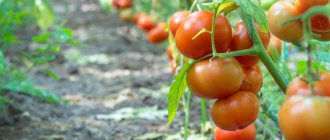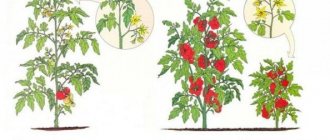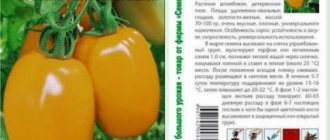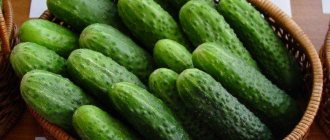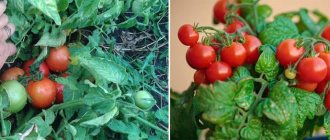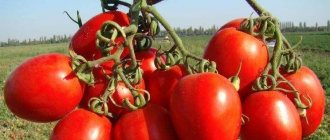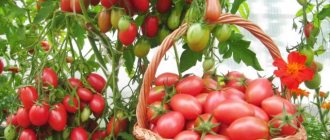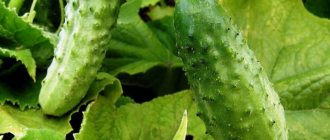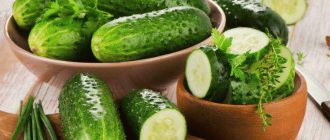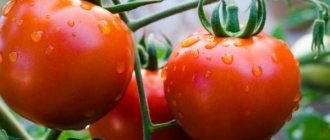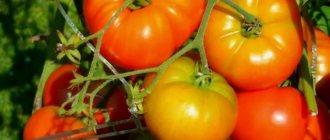If your region of residence does not have a warm climate and fertile soil, but you really want to grow a good crop of tomatoes, then low-growing greenhouse varieties will be the best choice. There are several dozen such varieties - vegetables differ from each other in shape, taste and color.
In this article we will look at the most popular varieties of low-growing tomatoes for the greenhouse and talk about the advantages and disadvantages of each.
Advantages of growing low-growing tomatoes in greenhouses
The advantages are as follows:
- ease of care. Due to their compact size, these tomatoes are convenient to grow in greenhouses, as they take up little space. The need to tie up bushes disappears, which means that you will spend less of your time;
- rapid ripening of tomatoes and stable yield;
- most varieties of low-growing greenhouse tomatoes are early ripening;
- resistance to common diseases.
Important! In addition to practical benefits, such bushes delight gardeners with their appearance - the beds look well-groomed and decorated. The decorative component in this case appeals to many summer residents.
Tomatoes in open ground
The most popular low-growing varieties
Consider the list of the most popular low-growing tomatoes:
- Big Mama. The bushes reach a height of 60 cm. The tomatoes themselves are large, red-raspberry in color. The shape is round, the peel is dense, glossy. The stem is powerful, the leaves are light green and medium in size. Tomatoes ripen 85 days after planting. Productivity is high - from 1 sq. m you can collect up to 10 kg of vegetables. They do not crack and are resistant to fungi and pests.
- Pink honey The name speaks for itself - tomatoes have a unique sweetish taste and juicy pulp. The ripening period ranges from 111 to 115 days. Productivity - up to 6 kg per bush. In the greenhouse, the height of the bushes reaches 1 m. The vegetable is used to prepare salads, side dishes, soups, tomato juice and pasta. Due to its thin skin and large size, Rose honey is not suitable for canning and pickling.
- Golden stream. The variety got its name from the orange-yellow color of the tomatoes. The weight of one varies from 70 to 80 g. The plant is characterized by good resistance to weather changes. The gold flow is growing well both in central Russia and in the southern regions.
- Red Fang. Externally, the tomato looks like a large fang - hence its name. The sweet, fleshy pulp appeals to many gardeners. The tomatoes themselves are large, weighing about 90 g per one. They are best used for fresh consumption.
- Little Red Riding Hood. This variety came to Russia from Germany. The variety does not require staking or pinching, so it is easy to care for. The height of the bushes is only 30 cm. The ultra-early variety can be planted both in a greenhouse and at home - on a balcony or windowsill. Red cap has a sweet pulp and an average number of seeds.
- Ob domes. The only drawback is the need to tie up and remove the stepsons. Otherwise, the Ob domes are universal. Resistance to diseases is high and tolerates unpredictable weather, for example, dry periods.
- Supermodel. This variety appeared in 2012. The weight of one red-pink tomato is approximately 100 g. One bush, with proper care, produces no more than 8 kg. Tomatoes have an excellent taste; it is preserved during cooking.
- Rajah. Tomatoes have thin skin and sweet, juicy flesh. Often used in the production of juices and seasonings. There are few seeds in tomatoes. Raja is characterized not only by good taste, but also by his presentable appearance. Therefore, the vegetable is often grown for sale.
- Watercolor. Stably produces many fruits and has high yields. Summer residents note that the number of vegetables harvested is not affected by either weather conditions or the climatic features of the growing region. The variety is universal in application. Watercolors are great for making adjika and spicy sauces.
- El Dorado. Dense tomatoes have an unusual orange-yellow color. The weight of one is about 400 g, the taste is good. The best predecessors for planting are cucumbers and potatoes. Due to its bright appearance, Eldorado is often used as a fresh snack.
- Gift for a woman. This variety is a real gift not only for women, but also for any summer resident. These tomatoes are perfectly stored and can be transported. The fruits are large and the yield is high. The weight of one tomato is 80-120 g.
- Grouse. The variety is early ripening, the first tomatoes appear 115 days after planting. The height of the bush is about 70 cm. It is unpretentious in care - the main thing is to water it on time and remove weeds. Due to excessive moisture, tomatoes crack, so it is important to follow the watering regime.
- Sanka. The variety was bred in 2003 by Russian agronomists. Has increased resistance to weather changes. Gives a good harvest even with a lack of light. In a greenhouse, the weight of one tomato can reach 150 g.
- Alaska. The fruits are medium-sized, round, deep red in color. The harvest is early and friendly - the tomatoes ripen at the same time. In addition to the greenhouse, Alaska is successfully grown on the balcony or windowsill of the house.
- Pink flamingo. Brings a good harvest in the Central region of Russia and the neighboring CIS countries. It has a long ripening period. Tomatoes require strong support and garter. The weight of one tomato reaches 450 g.
Precocious/early
Many low-growing tomato varieties are characterized by early ripening, which is especially important when grown in regions with short summers. In this category, you should pay attention to the following seeds:
- Pearl. The harvest can be harvested within 87 days after planting in the greenhouse. These will be medium-sized tomatoes weighing 30-40 g. There are three color options: red, pink and yellow. The plants themselves do not require complex care. It is enough to apply complex fertilizers and tie up the trunk so that it does not sag under the weight of ripening fruits.
- F1 doll. A low-growing hybrid with a ripening period of 85 days. On 1 m² of land you can get up to 9 kg of harvest with fleshy, sweet pulp, which can be used for various needs.
- Arctic. An unpretentious variety that tolerates temperature changes and lack of moisture well. Bushes up to 40 cm high do not require a garter and produce up to 25 round small tomatoes each. They begin to bear fruit in 80-87 days.
Related article:
Why do tomatoes have white streaks inside?
- "Katya F1". Hybrid with a ripening period of 75-80 days. Productivity reaches 12-14 kg per 1 m². One bunch produces 7-8 tomatoes weighing 90-130 g each. They have a round or flat-round shape, good taste with sweet notes.
- Visible and invisible. An early, low-growing variety with abundant fruiting, therefore, despite its small height (up to 40 cm), it requires a garter. Round, slightly flattened tomatoes are not prone to cracking. They come in two colors: pink and red. The first harvest will be larger (up to 280-330 g), subsequent ones - up to 200-300 g. You can get up to 4-5 kg of vegetables from a bush.
- Sanka. One of the best early varieties. Ripening occurs after 90 days and can last until frost. Productivity reaches 13-15 kg per 1 m². Thanks to their thick skin, the scarlet round fruits are suitable for salads, pickling, and pickling.
Related article:
The best low-growing tomatoes for open ground
Plants with a minimum ripening period will also be the best option for greenhouses infected with fungi or bacterial infections: the crop will ripen before the pathogens develop en masse.
Varieties for the Moscow region
Gardeners in the Moscow region distinguish the following among all low-growing varieties:
- Rocket . The height of the bushes is only about 40 cm, the average weight of the vegetable is about 50 g. Due to their compact size, tomatoes are suitable for winter harvesting.
- Blizzard . In greenhouse conditions, the maximum height of the bush is 70 cm. Tomatoes have a good shelf life and versatility in use. Metelitsa has a positive attitude towards mineral supplements. The first fertilizing can be applied after germination.
- Shuttle . Small, smooth fruits appear within 80 days from planting. Vegetables have a glossy surface, pleasant thin peel, and juicy pulp. 1 sq. m of beds with seedlings of such tomatoes gives from 5 to 8 kg of yield. The downside is that the plant is not resistant to diseases.
- Danko . Mid-season variety. The bushes are branched, height is about 60 cm. The variety has excellent resistance to drought. Does not tolerate transportation well and is prone to cracking.
- Winter cherry . Characterized by smooth, beautiful fruits. Summer residents harvest their first harvest within 95 days. Winter cherry has one disadvantage - low yield due to the limited number of brushes on the bush.
The best low-growing varieties for Siberia and the Urals
Weather conditions in these regions are not as favorable as in central Russia. However, there are varieties that give a good harvest even in harsh climates.
Among them:
- Siberian early ripening. Red round fruits ripen in greenhouse conditions for 100 days. Well developed susceptibility to diseases. They tend to ripen when picked indoors.
- Lucky F1. The tomato weighs about 120 g, the surface is smooth, the skin is of medium thickness. Lucky is often grown not only for personal consumption, but also for sale.
- Nastenka. The variety is stored for a long time without losing its taste and external qualities. The plant needs regular mineral feeding. Tomatoes especially love nitrogen-containing substances.
- Siberian Troika. The tomatoes are large, mid-season. Vegetable growers harvest up to 5 kg from one bush. Adapts to frost, drought, and other unfavorable conditions. Great for ketchup and juices.
- Far North . The bushes reach a height of 50 cm, the fruit is juicy and dense. Created specifically for Siberia and the Urals, it tolerates long-term absence of sun. Resistant to rot and fungi.
Late
Low-growing varieties intended for late harvesting are suitable for long-term storage of fresh tomatoes and other needs. In this category, you should pay attention to the following options:
- Titanium. Round, small fruits (up to 120 g) ripen in 135 days and can be used for all types of preparations. Adult plants grow no more than 50 cm, are resistant to fungi and other tomato diseases, are not sensitive to moisture deficiency, but require fertilizing during the period of active growth, gartering of trunks and do not respond well to a sharp drop in temperature.
- Rocket. Low bushes are resistant to all types of rot. Ripening occurs in 120-130 days. Per 1 m² you can collect up to 6-10 kg of elongated oval tomatoes weighing 50-60 g. They are suitable for canning, pickling, as well as long-term storage and transportation without loss of presentation.
- Finish. Gives a harvest in 130-135 days. Intensely red fruits weighing up to 90 g with juicy pulp have a dense skin that prevents them from cracking. They are distinguished by good keeping quality and transportability.
- Bobcat. A hybrid of Dutch origin with a growing season of 120-130 days, resistant to adverse weather conditions (including drought) and most diseases of nightshade crops. On bushes 50-70 cm high, slightly flattened tomatoes weighing up to 250-300 g ripen.
Related article:
Which pink tomatoes have high yields?
Features of variety selection
Choosing the best variety from such a variety is not easy. Determine for yourself what is important to you in the future harvest - the taste of vegetables, their size, resistance to disease, ease of care?
It is based on these characteristics that it will be easier for you to make a choice. Ask your gardener friends, they will help you make a choice from the point of view of not only theory, but also practice.
The sweetest low-growing varieties
Top 5 sweetest low-growing varieties:
- Danko.
- Philippok.
- Spring of the North.
- Doll Masha.
- Rajah.
Early ripening varieties
The fastest to ripen are:
- Winter cherry.
- Shuttle.
- Little Red Riding Hood.
- Pink honey
- Quiz.
Disease resistant
The following have good immunity:
- Alsou.
- Demidov.
- Oak.
- Lady fingers.
- Supermodel.
Yield varieties
You will be pleased with good returns:
- Barmaley.
- Miracle of the earth.
- Yellow pear.
- Zero.
- Arctic.
Varieties that do not require pinching
Tomatoes that do not require pinching and are therefore easy to care for:
- Alpha.
- Gavroche.
- Rose of Wind.
- Hurricane.
- Vershok.
- A little prince.
Large-fruited varieties
Despite the compact size of the bushes, these varieties are distinguished by large fruits:
- Big Mama.
- Red Fang.
- El Dorado.
- Pink flamingo.
- Siberian Troika.
Which low-growing tomatoes are best?
It is impossible to say that some varieties of low-growing tomatoes are better or worse. Low-growing tomatoes for greenhouses are represented by many varieties from different manufacturers. From all this diversity, every gardener can choose the most suitable variety, both in terms of bush size and fruit size.
Of the large-fruited varieties, tomatoes for greenhouses are low-growing; we can note such early varieties as:
- "Grouse"
- "Winnie the Pooh"
- "The Chosen One"
- "Rajah"
- "Hermitage Museum".
Tomato variety “Chosen One”
From hybrid varieties: “Major”, “Resource”, “Dushechka”, “Simona”, “Russian Troika”, “Ace”, “Torbey”, “Kuplet”.
Small-fruited tomatoes for greenhouses are low-growing, can be different in shape and color, as well as in terms of ripening.
Such varieties as “Salut”, with bright yellow fruits, have proven themselves well; "Boni-M" with bright red flat fruits; “Gem emerald”, whose tomatoes look like plums and are distinguished by a rich, truly emerald color; pink “Raisin”; “Pepper” with pepper-shaped fruits or graceful and beloved by many gardeners “Lady fingers”.
Such different tomatoes
When choosing seeds of low-growing tomatoes for growing in greenhouses, it is important to remember the peculiarities of their cultivation.
How to protect yourself from a bad seed purchase
To protect yourself from an unsuccessful purchase of seed, follow a number of simple rules:
- Before going to the store, consult with your summer residents. Find out what seeds they use and what crops they grow. If this is not possible, read several topical articles;
- study photographs of ready-made tomatoes on the Internet, mark for yourself the varieties that you like most;
- do not buy seeds from random sellers - it is better to go to a specialized store;
- ask the sales consultant all your questions;
- pay attention to the manufacturer - it is better to study reviews about it on the Internet in advance;
- read the information on the package - ripening period, characteristics, methods of care. Find out in which region of our country the variety will give the best harvest.
Tips and tricks
Even a novice gardener can grow a good harvest of low-growing greenhouse tomatoes. These varieties are unpretentious in care; many of them do not require staking or pinching. Most varieties are early ripening, so within about 2-2.5 months after planting you will receive the first fruits of your labors.
Important! Don't forget to water the beds on time. Do this as they dry. However, do not overdo it, as excess moisture causes the tomatoes to crack, which affects their taste and shelf life.
Also don't forget about organic fertilizers. The first fertilizers are applied after the first ovaries form. It is best to use monopotassium phosphate. Repeat feeding after 10 days. Minerals and other beneficial substances affect the quality of the future harvest and the taste of tomatoes.
In addition, you may encounter common diseases - late blight and mosaic. They destroy the crop, and you can only get rid of diseases with the help of professional means. Medicines for tomatoes are sold at any gardening store.
For long-term storage, it is best to wrap tomatoes in a sheet of paper and put them in a box. Place hay between the rows - this protection will keep the tomatoes intact during transportation.
